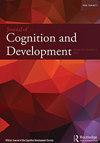理解数据:确定儿童的数据比较策略
IF 2.1
2区 心理学
Q3 PSYCHOLOGY, DEVELOPMENTAL
引用次数: 0
摘要
摘要数据的统计特性不存在于任何单个值中,而只能通过将集合视为一个整体来显现。总结集合的统计特性(例如,创建集合)在认知中无处不在,但一个尚未回答的问题是,这个过程如何随着发展而变化。数字集的性质(例如,均值)为研究摘要背后的机制提供了一个独特的机会。我们向来自美国中西部地区的四年级(约十岁)和六年级(约十二岁)儿童提出了一项数据比较任务,确定两名高尔夫球手中哪一名打出了最远的击球,并在解决每次测试时测量了他们的准确性、信心和眼睛注视模式。儿童的数据策略是通过对他们的眼动追踪模式进行编码来识别的。结果表明,准确度和置信度与集合的统计特性有关。美国年龄较大的儿童一贯使用一种策略,该策略显示出对诊断集合属性的关注(例如,关注集合中的大多数数字),而大多数年龄较小的儿童使用各种策略,其中许多不太准确(例如,只关注一组中的一个数字),或者使用相同的策略的效率低于年龄较大的儿童(例如,关注非诊断性位置值)。研究结果通过确定儿童用来理解数据的策略、他们的发展转变,以及儿童策略使用的变化如何成为理解总结环境中复杂信息的发展改进的关键组成部分,增加了我们对美国儿童定量推理的理解。本文章由计算机程序翻译,如有差异,请以英文原文为准。
Making Sense of Data: Identifying Children’s Strategies for Data Comparisons
ABSTRACT The statistical properties of data are not present in any individual value, but rather, emerge only by perceiving the set as a whole. Summarizing the statistical properties of sets (e.g., creating ensembles) is ubiquitous in cognition, yet one unanswered question is how this process changes over development. The properties of number sets (e.g., means) provide a unique opportunity to investigate the mechanisms underlying summarization. We presented fourth (~ten-year-old) and sixth grade (~twelve year-old) children from the Midwestern region of the United States with a data comparison task, determining which of two golfers produced the farthest drive, and measured their accuracy, confidence, and eye fixation patterns while solving each trial. Children’s data strategies were identified by coding their eye tracking patterns. The results demonstrated that accuracy and confidence were related to the statistical properties of the sets. Older US children consistently used a strategy that demonstrated attention to diagnostic set properties (e.g., attending to most numbers in a set), whereas most younger children used a variety of strategies, many of which were less accurate (e.g., attending to only one number in a set) or used the same strategies less efficiently than older children (e.g., attending to non-diagnostic place values). The results add to our understanding of US children’s quantitative reasoning by identifying strategies children use to make sense of data, their developmental transitions, and how changes in children’s strategy use is a key component in understanding the developmental improvements in summarizing complex information in the environment.
求助全文
通过发布文献求助,成功后即可免费获取论文全文。
去求助
来源期刊

Journal of Cognition and Development
Multiple-
CiteScore
4.00
自引率
0.00%
发文量
29
期刊介绍:
The Journal of Cognition and Development is the official journal of the Cognitive Development Society (CDS). Some CDS members are concerned with basic research or theory; others focus on policy issues and practical applications. The range of interests includes cognitive development during all stages of life, and we seek to understand ontogenetic processes in both humans and nonhumans. Finally, their interests encompass typical as well as atypical development, and we attempt to characterize both biological and cultural influences on cognitive change and continuity.
 求助内容:
求助内容: 应助结果提醒方式:
应助结果提醒方式:


